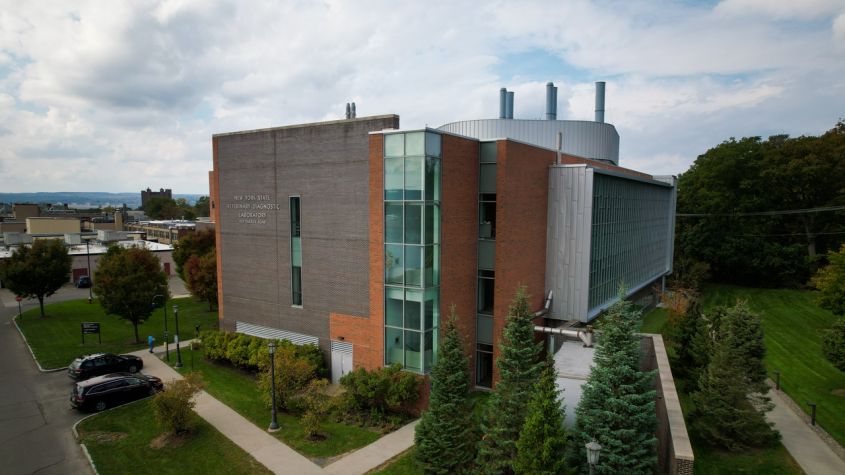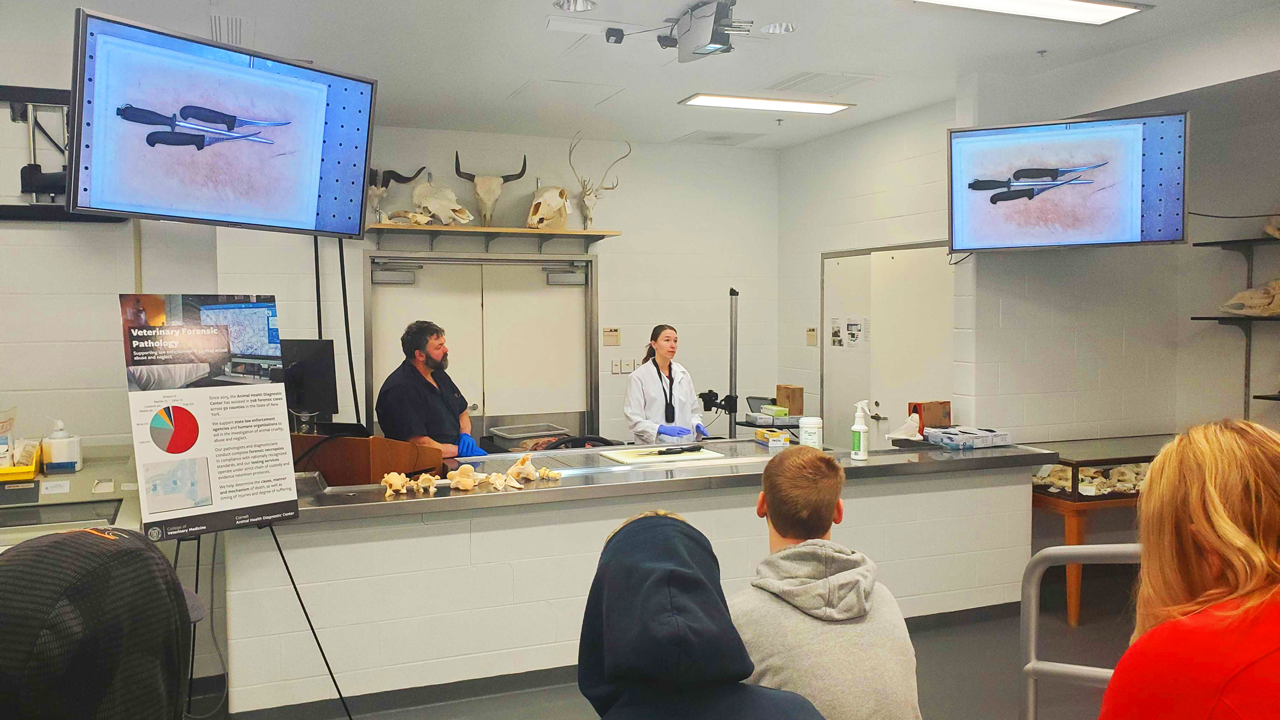“From a goldfish to an elephant”: Local high schoolers dive deep into veterinary diagnostics at Cornell
AHDC-Aerial-1280px.png

The agenda for each high school visit to the Animal Health Diagnostic Center is different depending on group composition, lab availability and time constraints. Photo: Tyn Parseghian/Eleven Lakes Media
On a snowy January morning, students from Homer High School boarded a bus to Cornell for a day of exploring veterinary careers. From handling deer skulls to touring barns, students discovered a depth and breadth of career options, particularly at the Animal Health Diagnostic Center (AHDC).
“We like having students visit and learn about what we do,” said diagnostic operations manager Martin Slade, who has coordinated many of these visits with high schools across the region. “People might think only veterinarians work here and we have so many other career opportunities at the AHDC.”
The students are from agriculture teacher Brooke Head’s animal science class. “I'm always looking for opportunities for students to learn more outside of the classroom,” she said. Head has taught at Homer High School for eight years and also runs its Future Farmers of America chapter. “This is a different experience for the kids than simply lecturing and writing and talking.”
The agenda for each visit is different depending on group composition, lab availability and time constraints. For these students, their time at the AHDC began with a welcome from Slade, who gave them an overview of veterinary laboratory diagnostics and the many units that comprise the AHDC.

“I like to cover all of what we do because it shows all the different types of careers as well as the different levels of education employees might have,” Slade said. The AHDC houses more than a dozen units, covering fields from clinical pathology to virology and administrative teams like quality management and client support.
Slade then walked the students through the AHDC’s newly renovated receiving laboratory, which processes over 750,000 samples annually, before leading them into an anatomic pathology show-and-tell session at the Kenneth Gumaer, D.V.M. ’43, Pathology Teaching Theater. There, students were able to observe and safely handle various animal organs and see tissues at a microscopic level on the monitors. Anatomic pathology’s necropsy laboratory collects many samples that are disbursed to various other AHDC labs for testing.
Anatomic pathology resident Dr. Maggie Marcinczyk and lead necropsy technician Dan Quaile walked them through the process of a standard necropsy. “Pathology is the study of diseases,” Marcinczyk said. “So my job is to distinguish between what’s normal and what’s abnormal in these tissues. For instance, if a dog dies and had a history of shortness of breath, I know to focus my efforts on the lungs to figure out the issue.” On hand were a range of anatomy specimens, including an elephant femur and a horse brain. Marcinczyk even showed them how she would assess heart muscles and the stomach contents of certain animals.
Quaile described how his responsibilities as a technician change daily. “I have my hands on all kinds of different animals, anything from a goldfish to an elephant,” Quaile said. “Dairy cows, horses, cats, dogs — it’s a widespread variety of species that we handle.”
The students interacted with the specimens and asked Marcinczyk and Quaile questions during the show-and-tell session. “I always try to make time for this event,” Marcinczyk said. “Even if it can benefit just one student, to get them interested in science, it’s worth it.”
Head agrees that showing the variety of career paths is key. “You can work in a place like the AHDC with a doctorate or a high school diploma or any in between, so that’s a huge selling point.”
At lunch, students heard from Andrew Miller ’01, D.V.M. ’05, associate professor and section chief of the anatomic pathology unit, about his own career path. “There are opportunities for everybody in a field like this,” Miller said.
They then walked across the facility to the Cornell Equine and Nemo Farm Animal Hospital to round out their tour of veterinary spaces at the college. Suzi DeSanti, animal care supervisor, and Kristen Pollack, animal care attendant, showed them the various barns, surgery suites and treatment areas for large animals of all kinds.
“We like to let them get a feel for the hospital,” DeSanti said. “We talk about animal care and technician roles, and how they can take those paths if they want to.”
Before Pollack joined the animal hospital as an animal care attendant, she herself was part of a careers tour at Cornell. “I visited in 2018 and asked a lot of questions. It was nice to talk to people who do these jobs on a daily basis,” Pollack said.
Tour concluded, the students hopped back on the bus to head back to Homer High School. Slade hopes the visit helped them picture themselves as potential future members of the veterinary diagnostics profession.
Head calls it a valuable experience. “I can talk about it all day, but it’s different when they see it with their own eyes,” she said. “You just don’t get that in a classroom.”
Written by Melanie Greaver Cordova




